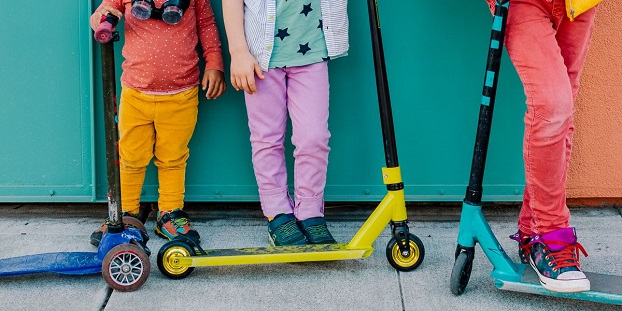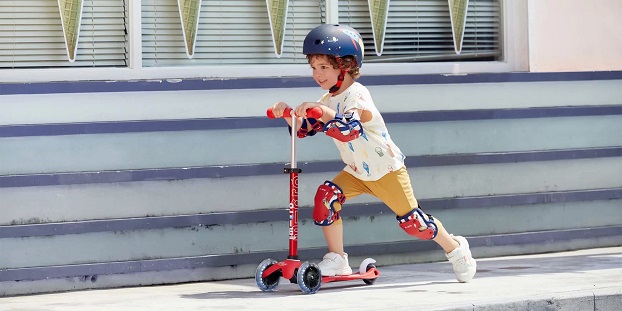Scooters became a popular option with kids and adults worldwide. Once your little one is ready to venture into the world, you’ll want to choose products that combine safety and enjoyment – two characteristics that perfectly represent the scooter riding experience.
What Are Children Scooters Beneficial For?

A lightweight scooter kids model will help your little one safely ride around while having a good time, and experience some of the finest health benefits this vehicle provides!
Motor Skills Development
Scootering requires the rider to use the arms and legs independently of one another, which helps to fine-tune motor abilities. The hands are on the handlebar, balancing the scooter, as one foot kicks while the other balances. All of this happens as the head and eyes are focused on reaching the right direction while scanning the area for any obstacles. If the youngster wants to stop, they will use one foot to press the rear fender brake pad while turning the scooter or slowing down sufficiently to safely place the other foot on the ground.
Muscle Development
Your kid needs core muscle strength for keeping balance, leg strength for driving the scooter with the foot, and mental strength for quick decision making. Every time your child rides a scooter, their muscles become stronger. The ankles, calves, hamstrings, and glutes are engaged when the youngster pushes off from a stop, and they are re-engaged every time they push to pick up speed. Staying upright requires the use of core muscles, such as the abdominal and lower back muscles. Scooters for kids are an excellent way to encourage muscle development and strength while having endless fun outdoors.
Balance & Coordination Development
A sense of balance is crucial for children’s proper development and learning. This is why scDootering is so enjoyable. The child must stand up straight and balance one leg while kicking with the other. Some starter scooters for kids contain a ‘lean-to steer’ feature as well as a steering lock, which promotes great balance while leaning through a turn.
Learning to balance the scooter with their weight from an early age can help the children develop good coordination. A growing child’s coordination benefits greatly from being able to steer, kick, balance, and brake at the same time. When they graduate from a three-wheeled scooter for kids to a two-wheeled scooter, coordination development accelerates as they learn to time their movements to maintain momentum, avoid obstacles, break and stop, and learn to do tricks.
Toddler’s Pre-Reading Skills Enhancement
All the health benefits from riding a scooter listed above are also necessary pre-reading abilities for toddlers. Our books are printed from left to right therefore new readers should be familiar with the concept of direction from a young age. Motor abilities are important for a variety of reasons. Kids must not only hold the books and turn the pages, but they must also have a good pencil grip to jot down words to remember them better.
Throughout their lifetimes, they’ll hone motor abilities to brush their teeth, type, and do various other activities.
Boosting Confidence
Even when toddlers can do a lot of things, there are still a great number of things they can’t do. Or, at the very least, things they believe they can’t do! Sometimes all your child needs is a boost of self-confidence to discover that they can accomplish “big kid” things—and learning to ride a scooter on their own could be the first step toward achieving their potential.
Usually, it doesn’t take long for kids to learn how to ride a scooter. Once they do, the knowledge that they can handle it may inspire them to take on new challenges and develop some new skills.
Decision Making Skills Enforcement
Riding a scooter kids model requires critical thinking and decision-making abilities. When riding a scooter, kids must make quick decisions such as when to slow down, when to stop, when to turn, and how much to lean into the steer without falling over. Keeping an eye out for potential stumbling blocks and considering how to best avoid them is a good example of decision-making skills enforcement. To stop in time, the youngster must swiftly consider how much force on apply to the brake or which way and when to turn to escape it. Kid scooters are an excellent way to teach your youngster how to make quick decisions and weigh possibilities.
How to Keep Your Kids Safe While Scootering

Make Them Wear a Helmet
Helmets for children are available in a wide range of sizes, so you should have no trouble choosing one that suits your youngster. The helmet should fit snugly and sit low on your child’s forehead; fasten any straps and buckles, and adjust the helmet to your child’s head with sizing pads if necessary.
Consider Knee and Elbow Pads
You and your child may feel safer knowing that some of the inevitable falls will be softened by protective gear, depending on where your child will be riding, how good they are, and how fast they may end up going. Because the elbows and knees are common targets for asphalt during falls, you can avoid bumps, bruises, cuts, and possibly fractures. It also establishes good habits for when they progress to more difficult rides.
Teach Them Road Safety
Your child may not understand that red denotes stop and green denotes go, or that the striped lines on the road are a crosswalk for pedestrians, cyclists, and, yes, scooter riders. When you first go out, spend some time showing your child the rules of the road or consider purchasing a picture book or handy poster so you can go over them again and again.
Buy Them Comfortable Footwear
When riding a scooter, kids should wear sneakers or at the very least a flexible, closed-toe shoe. It should also be well-fitting to avoid slipping off or entangled with anything. If the sneaker has laces, tighten them and, if feasible, tuck them inside the sneaker to avoid tangles.
Keep Repeating the Rules Every Time Your Kid Goes Outside
The rules may differ from one family to the next, but whatever they are, make sure you discuss them with your child before leaving the house. You can go through them quickly or, better yet, ask your youngster to tell you the rules, so you know they’ve understood. Have a plan on how to deal with your child if they break or ignore an important safety rule.





















